
Question Number 3662 by Filup last updated on 18/Dec/15
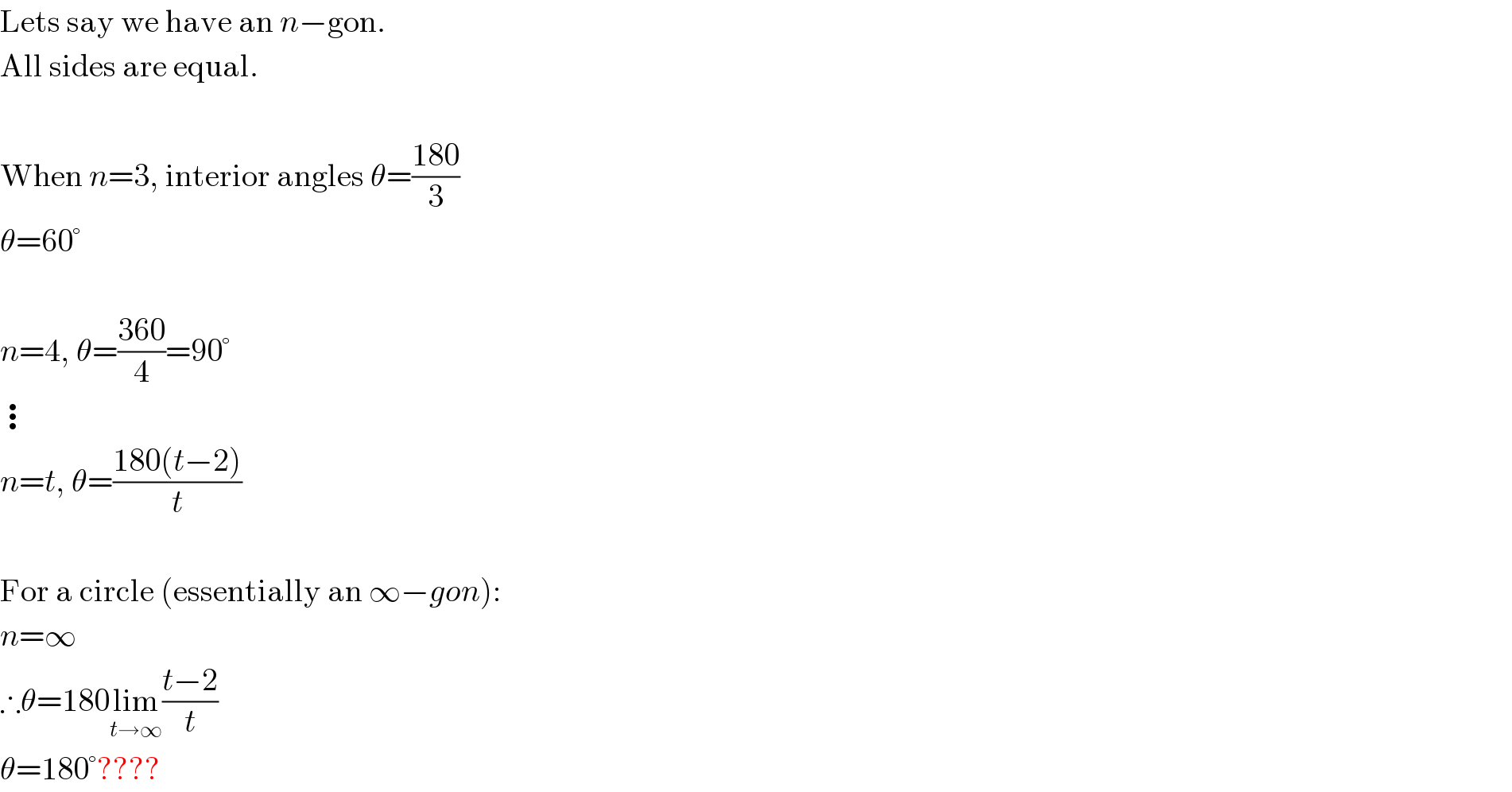
$$\mathrm{Lets}\:\mathrm{say}\:\mathrm{we}\:\mathrm{have}\:\mathrm{an}\:{n}−\mathrm{gon}. \\ $$$$\mathrm{All}\:\mathrm{sides}\:\mathrm{are}\:\mathrm{equal}. \\ $$$$ \\ $$$$\mathrm{When}\:{n}=\mathrm{3},\:\mathrm{interior}\:\mathrm{angles}\:\theta=\frac{\mathrm{180}}{\mathrm{3}} \\ $$$$\theta=\mathrm{60}° \\ $$$$ \\ $$$${n}=\mathrm{4},\:\theta=\frac{\mathrm{360}}{\mathrm{4}}=\mathrm{90}° \\ $$$$\vdots \\ $$$${n}={t},\:\theta=\frac{\mathrm{180}\left({t}−\mathrm{2}\right)}{{t}} \\ $$$$ \\ $$$$\mathrm{For}\:\mathrm{a}\:\mathrm{circle}\:\left(\mathrm{essentially}\:\mathrm{an}\:\infty−{gon}\right): \\ $$$${n}=\infty \\ $$$$\therefore\theta=\mathrm{180}\underset{{t}\rightarrow\infty} {\mathrm{lim}}\frac{{t}−\mathrm{2}}{{t}} \\ $$$$\theta=\mathrm{180}°???? \\ $$
Commented by prakash jain last updated on 18/Dec/15

$$\mathrm{Yes}. \\ $$
Commented by 123456 last updated on 18/Dec/15

$$\mathrm{visualy}\:\mathrm{as}\:\mathrm{the}\:\mathrm{number}\:\mathrm{of}\:\mathrm{angles}\:\mathrm{rises} \\ $$$$\mathrm{the}\:\mathrm{internal}\:\mathrm{angles}\:\mathrm{became}\:\mathrm{more}\:\mathrm{opened} \\ $$$$\mathrm{so}\:\mathrm{in}\:\mathrm{the}\:\mathrm{limit}\:\left(\mathrm{circle}\right)\:\mathrm{we}\:\mathrm{became}\:\mathrm{a}\:\mathrm{line} \\ $$$$\left(\mathrm{180}°\right) \\ $$
Commented by Filup last updated on 19/Dec/15

$$\mathrm{What}\:\:\mathrm{I}\:\mathrm{dont}\:\mathrm{understand}\:\mathrm{is}\:\mathrm{if}\:\theta=\mathrm{180}°, \\ $$$$\mathrm{shouldn}'\mathrm{t}\:\mathrm{the}\:\mathrm{shape}\:\mathrm{be}\:\mathrm{a}\:\mathrm{straight} \\ $$$$\mathrm{line}\:\mathrm{of}\:\mathrm{length}\:\mathrm{2}\pi{r}? \\ $$
Commented by Rasheed Soomro last updated on 19/Dec/15

$${What}\:{is}\:{the}\:{measure}\:{of}\:{the}\:{side}\:{of} \\ $$$${circle}\:{if}\:{it}\:{is}\:{considered}\:{as}\:\infty−{gon}?\:\mathrm{0}? \\ $$
Commented by 123456 last updated on 19/Dec/15
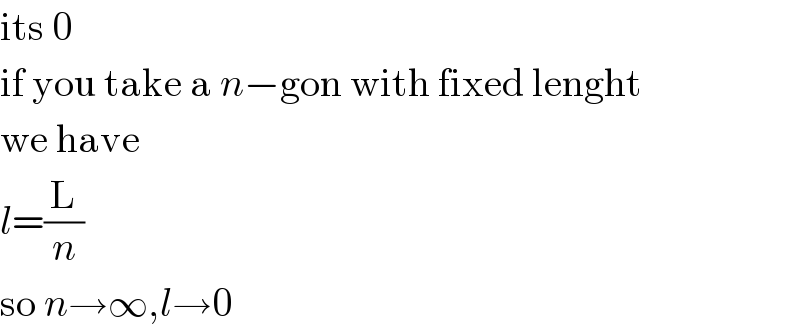
$$\mathrm{its}\:\mathrm{0} \\ $$$$\mathrm{if}\:\mathrm{you}\:\mathrm{take}\:\mathrm{a}\:{n}−\mathrm{gon}\:\mathrm{with}\:\mathrm{fixed}\:\mathrm{lenght} \\ $$$$\mathrm{we}\:\mathrm{have} \\ $$$${l}=\frac{\mathrm{L}}{{n}} \\ $$$$\mathrm{so}\:{n}\rightarrow\infty,{l}\rightarrow\mathrm{0} \\ $$
Commented by Rasheed Soomro last updated on 19/Dec/15

$${Then}\:{what}\:{is}\:{perimeter}/{circumference}? \\ $$$${Is}\:\:\mathrm{0}.\infty=\mathrm{2}\pi{r}\:? \\ $$
Commented by Filup last updated on 19/Dec/15
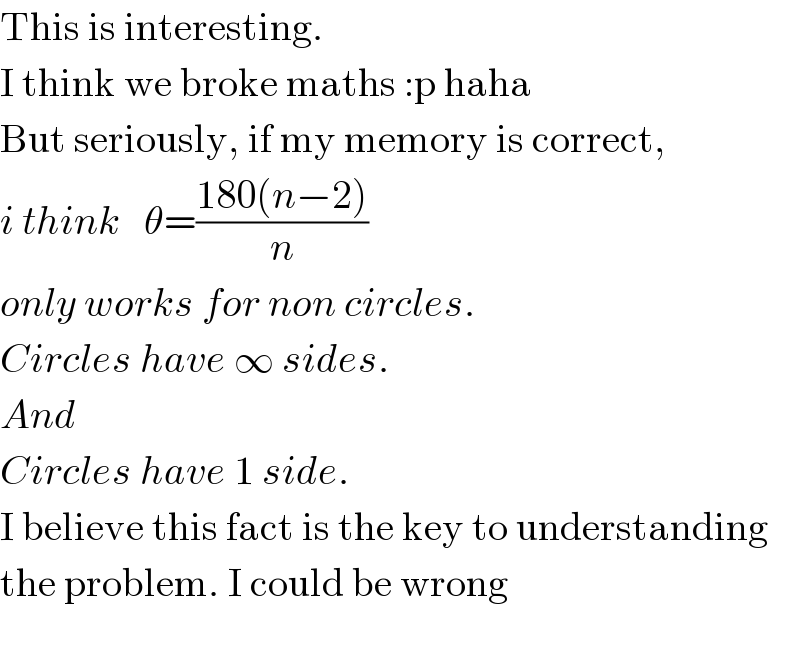
$$\mathrm{This}\:\mathrm{is}\:\mathrm{interesting}. \\ $$$$\mathrm{I}\:\mathrm{think}\:\mathrm{we}\:\mathrm{broke}\:\mathrm{maths}\::\mathrm{p}\:\mathrm{haha} \\ $$$$\mathrm{But}\:\mathrm{seriously},\:\mathrm{if}\:\mathrm{my}\:\mathrm{memory}\:\mathrm{is}\:\mathrm{correct}, \\ $$$${i}\:{think}\:\:\:\theta=\frac{\mathrm{180}\left({n}−\mathrm{2}\right)}{{n}} \\ $$$${only}\:{works}\:{for}\:{non}\:{circles}. \\ $$$${Circles}\:{have}\:\infty\:{sides}. \\ $$$${And} \\ $$$${Circles}\:{have}\:\mathrm{1}\:{side}. \\ $$$$\mathrm{I}\:\mathrm{believe}\:\mathrm{this}\:\mathrm{fact}\:\mathrm{is}\:\mathrm{the}\:\mathrm{key}\:\mathrm{to}\:\mathrm{understanding} \\ $$$$\mathrm{the}\:\mathrm{problem}.\:\mathrm{I}\:\mathrm{could}\:\mathrm{be}\:\mathrm{wrong} \\ $$$$ \\ $$
Commented by Filup last updated on 19/Dec/15
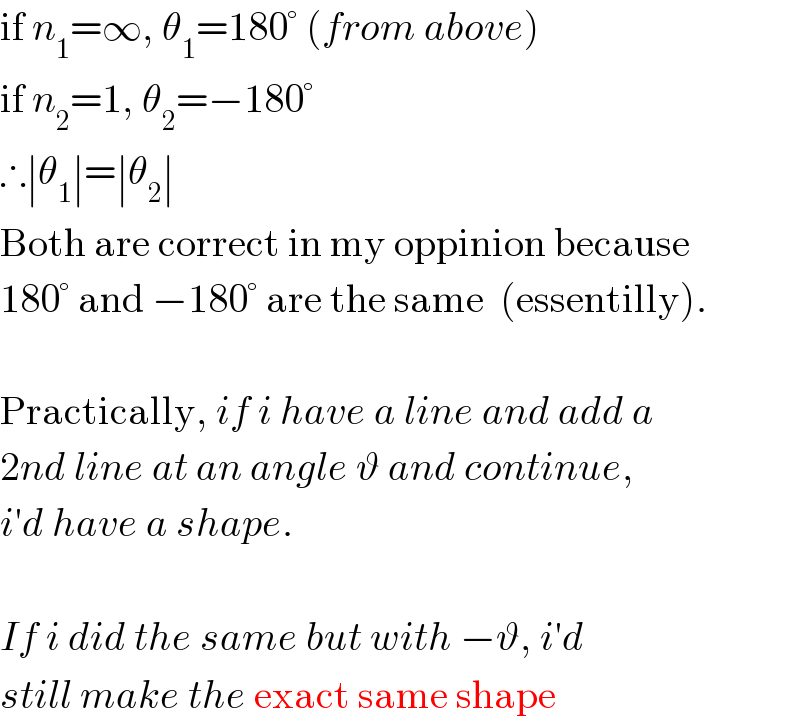
$$\mathrm{if}\:{n}_{\mathrm{1}} =\infty,\:\theta_{\mathrm{1}} =\mathrm{180}°\:\left({from}\:{above}\right) \\ $$$$\mathrm{if}\:{n}_{\mathrm{2}} =\mathrm{1},\:\theta_{\mathrm{2}} =−\mathrm{180}° \\ $$$$\therefore\mid\theta_{\mathrm{1}} \mid=\mid\theta_{\mathrm{2}} \mid \\ $$$$\mathrm{Both}\:\mathrm{are}\:\mathrm{correct}\:\mathrm{in}\:\mathrm{my}\:\mathrm{oppinion}\:\mathrm{because} \\ $$$$\mathrm{180}°\:\mathrm{and}\:−\mathrm{180}°\:\mathrm{are}\:\mathrm{the}\:\mathrm{same}\:\:\left(\mathrm{essentilly}\right). \\ $$$$ \\ $$$$\mathrm{Practically},\:{if}\:{i}\:{have}\:{a}\:{line}\:{and}\:{add}\:{a} \\ $$$$\mathrm{2}{nd}\:{line}\:{at}\:{an}\:{angle}\:\vartheta\:{and}\:{continue}, \\ $$$${i}'{d}\:{have}\:{a}\:{shape}. \\ $$$$ \\ $$$${If}\:{i}\:{did}\:{the}\:{same}\:{but}\:{with}\:−\vartheta,\:{i}'{d} \\ $$$${still}\:{make}\:{the}\:\mathrm{exact}\:\mathrm{same}\:\mathrm{shape} \\ $$
Commented by prakash jain last updated on 19/Dec/15
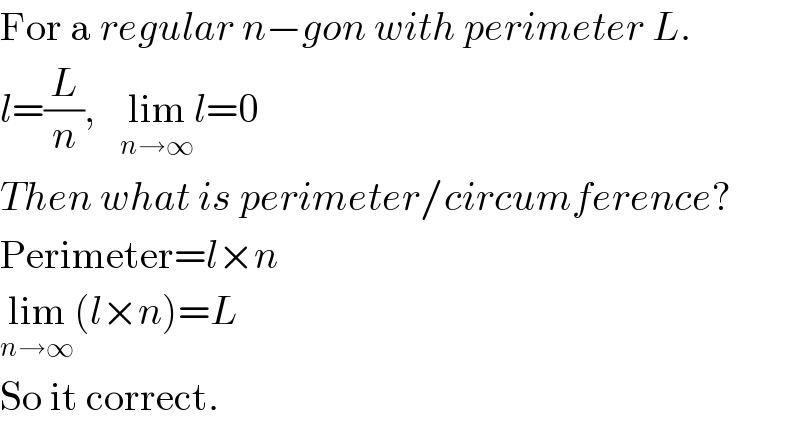
$$\mathrm{For}\:\mathrm{a}\:{regular}\:{n}−{gon}\:{with}\:{perimeter}\:{L}. \\ $$$${l}=\frac{{L}}{{n}},\:\:\:\underset{{n}\rightarrow\infty} {\mathrm{lim}}{l}=\mathrm{0} \\ $$$${Then}\:{what}\:{is}\:{perimeter}/{circumference}? \\ $$$$\mathrm{Perimeter}={l}×{n} \\ $$$$\underset{{n}\rightarrow\infty} {\mathrm{lim}}\left({l}×{n}\right)={L} \\ $$$$\mathrm{So}\:\mathrm{it}\:\mathrm{correct}. \\ $$
Commented by prakash jain last updated on 19/Dec/15

$$\mathrm{Also}\:\theta=\frac{\mathrm{180}\left({n}−\mathrm{2}\right)}{\mathrm{2}}\:{is}\:{valid}\:{for}\:{n}>\mathrm{2}. \\ $$$${closed}\:{figure}\:{is}\:{assumed}\:{in}\:{the}\:{formula}. \\ $$
Commented by prakash jain last updated on 19/Dec/15
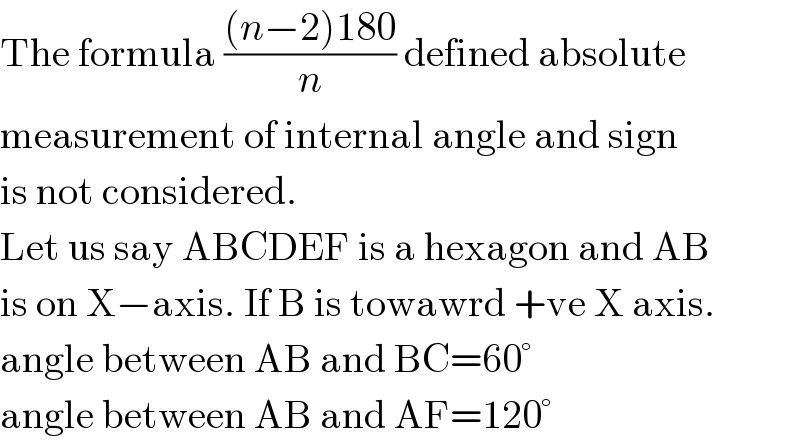
$$\mathrm{The}\:\mathrm{formula}\:\frac{\left({n}−\mathrm{2}\right)\mathrm{180}}{{n}}\:\mathrm{defined}\:\mathrm{absolute} \\ $$$$\mathrm{measurement}\:\mathrm{of}\:\mathrm{internal}\:\mathrm{angle}\:\mathrm{and}\:\mathrm{sign} \\ $$$$\mathrm{is}\:\mathrm{not}\:\mathrm{considered}. \\ $$$$\mathrm{Let}\:\mathrm{us}\:\mathrm{say}\:\mathrm{ABCDEF}\:\mathrm{is}\:\mathrm{a}\:\mathrm{hexagon}\:\mathrm{and}\:\mathrm{AB} \\ $$$$\mathrm{is}\:\mathrm{on}\:\mathrm{X}−\mathrm{axis}.\:\mathrm{If}\:\mathrm{B}\:\mathrm{is}\:\mathrm{towawrd}\:+\mathrm{ve}\:\mathrm{X}\:\mathrm{axis}. \\ $$$$\mathrm{angle}\:\mathrm{between}\:\mathrm{AB}\:\mathrm{and}\:\mathrm{BC}=\mathrm{60}° \\ $$$$\mathrm{angle}\:\mathrm{between}\:\mathrm{AB}\:\mathrm{and}\:\mathrm{AF}=\mathrm{120}° \\ $$
